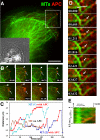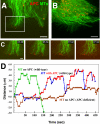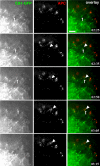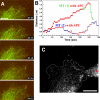Adenomatous polyposis coli on microtubule plus ends in cell extensions can promote microtubule net growth with or without EB1
- PMID: 16525027
- PMCID: PMC1446093
- DOI: 10.1091/mbc.e05-06-0498
Adenomatous polyposis coli on microtubule plus ends in cell extensions can promote microtubule net growth with or without EB1
Abstract
In interphase cells, the adenomatous polyposis coli (APC) protein accumulates on a small subset of microtubules (MTs) in cell protrusions, suggesting that APC may regulate the dynamics of these MTs. We comicroinjected a nonperturbing fluorescently labeled monoclonal antibody and labeled tubulin to simultaneously visualize dynamics of endogenous APC and MTs in living cells. MTs decorated with APC spent more time growing and had a decreased catastrophe frequency compared with non-APC-decorated MTs. Endogenous APC associated briefly with shortening MTs. To determine the relationship between APC and its binding partner EB1, we monitored EB1-green fluorescent protein and endogenous APC concomitantly in living cells. Only a small fraction of EB1 colocalized with APC at any one time. APC-deficient cells and EB1 small interfering RNA showed that EB1 and APC localized at MT ends independently. Depletion of EB1 did not change the growth-stabilizing effects of APC on MT plus ends. In addition, APC remained bound to MTs stabilized with low nocodazole, whereas EB1 did not. Thus, we demonstrate that the association of endogenous APC with MT ends correlates directly with their increased growth stability, that this can occur independently of its association with EB1, and that APC and EB1 can associate with MT plus ends by distinct mechanisms.
Figures







Similar articles
-
Dissecting interactions between EB1, microtubules and APC in cortical clusters at the plasma membrane.J Cell Sci. 2002 Apr 15;115(Pt 8):1583-90. doi: 10.1242/jcs.115.8.1583. J Cell Sci. 2002. PMID: 11950877 Free PMC article.
-
Adenomatous polyposis coli and EB1 localize in close proximity of the mother centriole and EB1 is a functional component of centrosomes.J Cell Sci. 2004 Mar 1;117(Pt 7):1117-28. doi: 10.1242/jcs.00939. Epub 2004 Feb 17. J Cell Sci. 2004. PMID: 14970257 Free PMC article.
-
The dynamic behavior of the APC-binding protein EB1 on the distal ends of microtubules.Curr Biol. 2000 Jul 13;10(14):865-8. doi: 10.1016/s0960-9822(00)00600-x. Curr Biol. 2000. PMID: 10899006
-
The APC-EB1 interaction.Adv Exp Med Biol. 2009;656:41-50. doi: 10.1007/978-1-4419-1145-2_4. Adv Exp Med Biol. 2009. PMID: 19928351 Review.
-
TIP maker and TIP marker; EB1 as a master controller of microtubule plus ends.J Cell Biol. 2005 Oct 24;171(2):197-200. doi: 10.1083/jcb.200509150. J Cell Biol. 2005. PMID: 16247021 Free PMC article. Review.
Cited by
-
+TIPs: SxIPping along microtubule ends.Trends Cell Biol. 2012 Aug;22(8):418-28. doi: 10.1016/j.tcb.2012.05.005. Epub 2012 Jun 28. Trends Cell Biol. 2012. PMID: 22748381 Free PMC article. Review.
-
Adenomatous polyposis coli is differentially distributed in growth cones and modulates their steering.J Neurosci. 2007 Nov 14;27(46):12590-600. doi: 10.1523/JNEUROSCI.2250-07.2007. J Neurosci. 2007. PMID: 18003838 Free PMC article.
-
Role of APC and its binding partners in regulating microtubules in mitosis.Adv Exp Med Biol. 2009;656:65-74. doi: 10.1007/978-1-4419-1145-2_6. Adv Exp Med Biol. 2009. PMID: 19928353 Free PMC article. Review.
-
Adenomatous polyposis coli regulates endothelial cell migration independent of roles in beta-catenin signaling and cell-cell adhesion.Mol Biol Cell. 2010 Aug 1;21(15):2611-23. doi: 10.1091/mbc.e10-03-0235. Epub 2010 Jun 2. Mol Biol Cell. 2010. PMID: 20519433 Free PMC article.
-
KIF17 stabilizes microtubules and contributes to epithelial morphogenesis by acting at MT plus ends with EB1 and APC.J Cell Biol. 2010 Aug 9;190(3):443-60. doi: 10.1083/jcb.201006044. J Cell Biol. 2010. PMID: 20696710 Free PMC article.
References
-
- Adams, M. C., Matov, A., Yarar, D., Gupton, S. L., Danuser, G., and Waterman-Storer, C. M. (2004). Signal analysis of total internal reflection fluorescent speckle microscopy (TIR-FSM) and wide-field epi-fluorescence FSM of the actin cytoskeleton and focal adhesions in living cells. J. Microsc. 216, 138-152. - PubMed
-
- Adams, M. C., Salmon, W. C., Gupton, S. L., Cohan, C. S., Wittmann, T., Prigozhina, N., and Waterman-Storer, C. M. (2003). A high-speed multispectral spinning-disk confocal microscope system for fluorescent speckle microscopy of living cells. Methods 29, 29-41. - PubMed
-
- Akhmanova, A., and Hoogenraad, C. C. (2005). Microtubule plus-end-tracking proteins: mechanisms and functions. Curr. Opin. Cell Biol. 17, 47-54. - PubMed
-
- Akhmanova, A., et al. (2001). CLASPs are CLIP-115 and -170 associating proteins involved in the regional regulation of microtubule dynamics in motile fibroblasts. Cell 104, 923-935. - PubMed
-
- Allan, V., and Näthke, I. S. (2001). Catch and pull a microtubule: getting a grasp on the cortex. Nat. Cell Biol. 3, E226-E228. - PubMed
Publication types
MeSH terms
Substances
Grants and funding
LinkOut - more resources
Full Text Sources
Molecular Biology Databases

